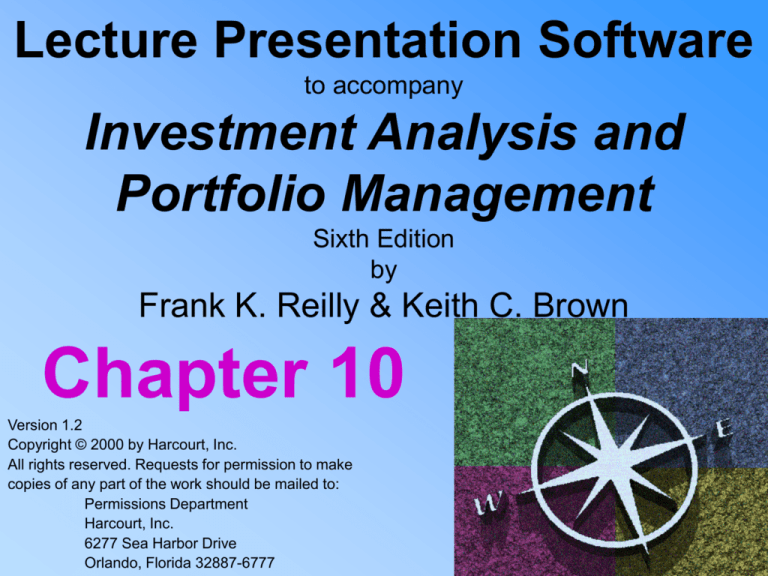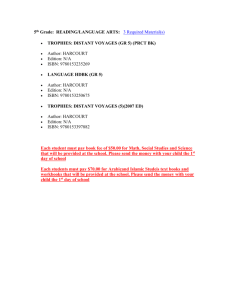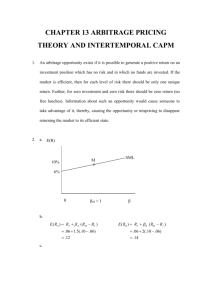
Lecture Presentation Software
to accompany
Investment Analysis and
Portfolio Management
Sixth Edition
by
Frank K. Reilly & Keith C. Brown
Chapter 10
Version 1.2
Copyright © 2000 by Harcourt, Inc.
All rights reserved. Requests for permission to make
copies of any part of the work should be mailed to:
Permissions Department
Harcourt, Inc.
6277 Sea Harbor Drive
Orlando, Florida 32887-6777
Chapter 10 - Extensions and
Testing of Asset Pricing Theories
Questions to be answered:
• What happens to the capital market line (CML)
when you assume there are differences in the
risk-free borrowing and lending rates?
• What is a zero-beta asset and how does its use
impact the CML?
• What happens to the security market line (SML)
when you assume transaction costs,
heterogeneous expectations, different planning
periods, and taxes?
Copyright © 2000 by Harcourt, Inc. All rights reserved.
Chapter 10 - Extensions and
Testing of Asset Pricing Theories
• What are the major questions considered when
empirically testing the CAPM?
• What are the empirical results from tests that
examine the stability of beta?
• How do alternative published estimates of beta
compare?
• What are the empirical test results of studies that
examine the relationship between systematic risk
and return?
Copyright © 2000 by Harcourt, Inc. All rights reserved.
Chapter 10 - Extensions and
Testing of Asset Pricing Theories
• What other variables besides beta have had a
significant impact on returns?
• What is the theory and practice regarding the
“market portfolio”? How does this difference
between theory and the market proxy relate to
the benchmark problem?
• Assuming there is a benchmark problem, what
variables are affected by it?
• What are the major assumptions not required by
the APT model compared to the CAPM?
Copyright © 2000 by Harcourt, Inc. All rights reserved.
Chapter 10 - Extensions and
Testing of Asset Pricing Theories
• How do you test the APT by examining
anomalies found with the CAPM?
• What are the empirical test results related to the
APT?
• Why do some authors contend that the APT
model is untestable?
• What are the concerns related to the multiple
factors of the APT model?
Copyright © 2000 by Harcourt, Inc. All rights reserved.
Relaxing the Assumptions
of the CAPM
• CAPM assumption: all investors can borrow or
lend at the risk-free rate - unrealistic
– Differential borrowing and lending rates
– Unlimited lending at risk-free rate
– Borrowing at higher rate
Copyright © 2000 by Harcourt, Inc. All rights reserved.
Investment Alternatives When The Cost of
Borrowing is Higher Than The Cost of Lending
Figure 10.1
E(R)
G
K
F
Rb
RFR
Risk (standard deviation s)
Copyright © 2000 by Harcourt, Inc. All rights reserved.
Relaxing the Assumptions
of the CAPM
• Zero-beta portfolio: create a portfolio that is
uncorrelated to the market (beta 0)
– The return of the zero-beta portfolio may differ from
the risk-free rate
• Any combination of portfolios on the efficient
frontier will be on the frontier
• Any efficient portfolio will have associated with it
a zero-beta portfolio
Copyright © 2000 by Harcourt, Inc. All rights reserved.
Implications of
Black’s Zero-beta model
• The expected return of any security can be expressed as
a linear relationship of any two efficient portfolios
E(Ri) = E(Rz) + bi[E(Rm) - E(Rz)]
• If original CAPM defines the relationship between risk
and return, then the return on the zero-beta portfolio
should equal RF
– Typically, in real world, RFR < E(RZ), so the zero-beta SML
would be less steep than the original SML
– Consistent with empirical results of tests of original CAPM
• To test directly - identify a market portfolio and solve
for the return of a zero-beta portfolio
– Leads to less consistent results
Copyright © 2000 by Harcourt, Inc. All rights reserved.
Security Market Line
With A Zero-Beta Portfolio
Figure 10.2
E(R)
SML
M
E(Rm)
E(Rm) - E(Rz)
E(Rz)
0.0
1.0
Copyright © 2000 by Harcourt, Inc. All rights reserved.
bi
Relaxing the Assumptions
of the CAPM
• Another assumption of CAPM – zero transactions
costs
• Transaction costs
– affect mispricing corrections
– affect diversification
Copyright © 2000 by Harcourt, Inc. All rights reserved.
Security Market Line
With Transaction Costs
Figure 10.3
E(R)
SML
E(Rm)
E(RFR)
or
E(Rz)
0.0
1.0
Copyright © 2000 by Harcourt, Inc. All rights reserved.
bi
Relaxing the Assumptions
of the CAPM
• Heterogenous expectations
– If all investors have different expectations about risk and
return, each investor would have a different idea about the
position and composition of the efficient frontier, hence would
have a different idea about the location and composition of the
tangency portfolio, M
– Hence, each would have a unique CML and/or SML, and the
composite graph would be a band of lines with a breadth
determined by the divergence of expectations
– Since each investor would have a different idea about where
the SML lies, each would also have unique conclusions about
which securities are under- and which are over-valued
– Also note that small differences in initial expectations can lead
to vastly different conclusions in this regard!
Copyright © 2000 by Harcourt, Inc. All rights reserved.
Relaxing the Assumptions
of the CAPM
• Planning periods
– CAPM is a one period model, and the period
employed should be the planning period for the
individual investor, which will vary by individual,
affecting both the CML and the SML
• Taxes
– Tax rates affect returns
– Tax rates differ between individuals and institutions
Copyright © 2000 by Harcourt, Inc. All rights reserved.
Empirical Testing of CAPM
Key questions asked:
• How stable is the measure of systematic
risk (beta)?
• Is there a positive linear relationship as
hypothesized between beta and the rate
of return on risky assets?
• How well do returns conform to the SML
equation?
Copyright © 2000 by Harcourt, Inc. All rights reserved.
Empirical Testing of CAPM
• Beta is not stable for individual stocks over
short periods of time (52 weeks or less)
• Stability increases significantly for portfolios
• The larger the portfolio and the longer the
period, the more stable the beta of the
portfolio
• Betas tend to regress toward the mean
Copyright © 2000 by Harcourt, Inc. All rights reserved.
Empirical Testing of CAPM
• Different estimates of beta for a stock vary
typically in data used
• Value Line estimates use 260 weekly observations
and compare to the NYSE Composite Index
• Merrill Lynch estimates use 60 monthly
observations and compare to the S&P 500
• bML 0.127 + 0.879bVL
• Securities market value affects the size and
direction of the interval affect
• Trading volume also affects the beta estimates
Copyright © 2000 by Harcourt, Inc. All rights reserved.
Relationship Between
Systematic Risk and Return
• Sharpe and Cooper: positive, but non-linear
• Douglas: intercept higher than the risk-free rate
• Miller and Scholes: possible error in Douglas findings –
need to account for effects of skewness
• Black, Jensen, and Scholes: positive linear relationship
between monthly excess return and portfolio beta
• Fama and McBeth: support the CAPM with the intercept
equal to the RFR
Copyright © 2000 by Harcourt, Inc. All rights reserved.
Relationship Between
Systematic Risk and Return
• Effect of skewness on the relationship
– preference for high risk and returns
• Effect of size, P/E and leverage
• Effect of book-to-market value
– The Fama and French Study (discussed in
Introductory notes)
Copyright © 2000 by Harcourt, Inc. All rights reserved.
The Market Portfolio:
Theory Versus Practice
• Difficult to test full market
• Portfolio used as market proxy may be
correlated to true market portfolio
• Benchmark error – 2 possible effects:
– Beta will be wrong
– SML will be wrong
Copyright © 2000 by Harcourt, Inc. All rights reserved.
Criticism of CAPM by Richard Roll
• Limits on tests: only testable implication
from CAPM is whether the market portfolio
lies on the efficient frontier
• Range of SML’s - infinite number of
possible SML’s, each of which produces a
unique estimate of beta
Copyright © 2000 by Harcourt, Inc. All rights reserved.
Criticism of CAPM by Richard Roll
• Market efficiency effects - substituting a
proxy, such as the S&P 500, creates two
problems
– Proxy does not represent the true market
portfolio
– Even if the proxy is not efficient, the market
portfolio might be (or vice versa)
Copyright © 2000 by Harcourt, Inc. All rights reserved.
Criticism of CAPM by Richard Roll
• Conflicts between proxies - different
substitutes may be highly correlated even
though some may be efficient and others are
not, which can lead to different conclusions
regarding beta risk/return relationships
• So, CAPM is not testable - but it still has
value and must be used carefully
• Stephen Ross devised an alternative way to
look at asset pricing - APT
Copyright © 2000 by Harcourt, Inc. All rights reserved.
Arbitrage Pricing Theory - APT
• Arbitrage is a process of buying a lower priced
asset and selling a higher priced asset, both of
similar risk, and capturing the difference in
arbitrage profits
• The general arbitrage principle states that two
identical securities will sell at identical prices
– “Law of One Price”
• Price differences will immediately disappear as
arbitrage takes place
Copyright © 2000 by Harcourt, Inc. All rights reserved.
Arbitrage Pricing Theory - APT
Three major assumptions:
1. Capital markets are perfectly competitive
2. Investors always prefer more wealth to
less wealth with certainty
3. The stochastic process generating asset
returns can be expressed as a linear function
of a set of K factors or indexes
Copyright © 2000 by Harcourt, Inc. All rights reserved.
Arbitrage Pricing Theory - APT
Ri Ei bi1 1 bi 2 2 bik k i for i 1 to N
Ri return on asset i during a specified time period
Ei expected return for asset i if all the factors or
indexes have zero changes
bik reaction in asset i ' s returns to movements in a
comon factor K or index K
k a set of common factors or indexes with a zero
mean that influences the returns of all assets
i a unique effect on asset i ' s return (random error)
N number of assets
Copyright © 2000 by Harcourt, Inc. All rights reserved.
Roll-Ross Study
1. Estimate the expected returns and the factor
coefficients from time-series data on
individual asset returns
2. Use these estimates to test the basic crosssectional pricing conclusion implied by the
APT
Copyright © 2000 by Harcourt, Inc. All rights reserved.
Extensions of the
Roll-Ross Study
• Cho, Elton, and Gruber examined the
number of factors in the return-generating
process that were priced
• Dhrymes, Friend, and Gultekin (DFG)
reexamined techniques and their limitations
and found the number of factors varies with
the size of the portfolio
Copyright © 2000 by Harcourt, Inc. All rights reserved.
The APT and Anomalies
• Small-firm effect
Reinganum - results inconsistent with the APT
Chen - supported the APT model over CAPM
• January anomaly
Gultekin - APT not better than CAPM
Burmeister and McElroy - effect not captured by model,
but still rejected CAPM in favor of APT
• APT and inflation
Elton, Gruber, and Rentzler - analyzed real returns
Copyright © 2000 by Harcourt, Inc. All rights reserved.
The Shanken Challenge to
Testability of the APT
• If returns are not explained by a model, it is not considered
rejection of a model; however if the factors do explain
returns, it is considered support
• APT has no advantage because the factors need not be
observable, so equivalent sets may conform to different
factor structures
• Empirical formulation of the APT may yield different
implications regarding the expected returns for a given set
of securities
• Thus, the theory cannot explain differential returns between
securities because it cannot identify the relevant factor
structure that explains the differential returns
Copyright © 2000 by Harcourt, Inc. All rights reserved.
Alternative Testing Techniques
• Jobson proposes APT testing with a
multivariate linear regression model
• Brown and Weinstein propose using a
bilinear paradigm
• Others propose new methodologies
Copyright © 2000 by Harcourt, Inc. All rights reserved.
The Internet
Investments Online
www.barra.com
www.wsharpe.com
www.cob.ohio-state.edu/~fin/journal.jof.htm
www3.oup.co.uk/revfin/scope
Copyright © 2000 by Harcourt, Inc. All rights reserved.
End of Chapter 10
–Extensions and Testing of Asset
Pricing Theories
Copyright © 2000 by Harcourt, Inc. All rights reserved.
Future topics
Chapter 7
• Importance of Efficient Capital Markets
• Alternative Efficient Market Hypotheses
• Efficient Markets and
– Technical Analysis
– Fundamental Analysis
– Portfolio Management
• “Shift Happens” - Mauboussin
• “The Wrong 20-Yard Line” - Haugen
Copyright © 2000 by Harcourt, Inc. All rights reserved.
Copyright © 2000 by Harcourt, Inc. All rights reserved.







